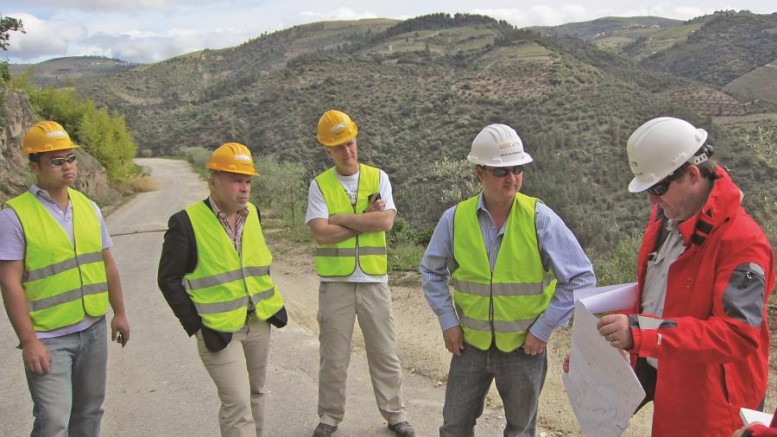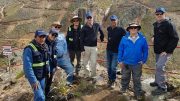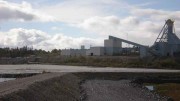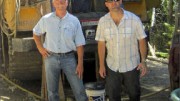Colt Resources (GTP-V, COLTF-O) has lofty plans to bring the next gold and tungsten mines to Portugal, a country perhaps best known for its fortified wines.
The junior’s motto is “A gold company created by investors for investors,” and the catchphrase holds some truth. Colt’s vice-president and chief operating officer Declan Costelloe first became aware of the junior as an investor, while running an independent mining consulting firm.
Shortly after, Colt’s president and CEO Nikolas Perrault invited the chartered engineer and mining geologist to visit the company. He joined the advisory board in early 2010, and then became a director before stepping into his current position last February.
“Because I liked active investing, I saw an opportunity to really invest my time and energy to work with Nikolas and the management of this company,” Costelloe tells a group of analysts, shareholders and The Northern Miner during a presentation in late May.
To develop better relationships in the country and to oversee exploration, Costelloe and Perrault moved their families to Portugal.
The Montreal-based junior is the country’s largest mineral holder, with claims sprawling 1,620 sq. km. “This actually places us in a rather unique position in relation to the government at a time of economic uncertainty,” Costelloe notes, explaining the government has been supportive of Colt’s initiatives as it creates employment and revenue opportunities.
The entity was formed in 2007, after Perrault — having spent 15 years with several major investment banks — decided it was time for a career change. Since then, he and his team have been active in the country.
Colt’s management includes Aurelio Useche as chief financial officer; David Johnson, chief legal officer and corporate secretary; Natalia Sokolova, vice-president of investor relations; Christophe Romary, vice-president of business development; Jorge Valente, vice-president of engineering and development; Joao Carlos de Sousa, vice-president of operations; Filipe Faria, vice-president of exploration; and Steven McRobbie, vice-president of mining geology.
When Colt started exploration five years ago, its focus was the Penedono gold project. That all changed following promising results from the Tabuaco tungsten project and the recently permitted Boa Fé-Montemor gold project.
Last November, Colt received a trial mining licence for the 47-sq.-km Boa Fé area, which is surrounded by the company’s wholly owned 732 sq. km Montemor exploration gold concession, in southern Portugal’s Alentejo region.
Since then, Colt has been replicating the previous drilling to validate several historical resource estimates and fast track the project towards mining. It anticipates receiving a full mining licence for the project in late 2013.
The core philosophy is to add value by demonstrating the presence of gold here, Costelloe says during the presentation.
Colt had six drills turning on site in May, so it could complete an initial National Instrument 43-101 compliant resource estimate at the project’s Chaminé and Casas Novas deposits.
Boa Fé-Montemor is located 95 km east of Lisbon. Getting from the tree-lined boulevards of Portugal’s capital to the rolling countryside takes an hour and half by paved roads and highways.
Once at Colt’s exploration office, Costelloe and CEO Perrault show off the heavily packed core shack before retelling the project’s history.
The facility contains 30 years of historical data that the junior acquired when it bought the project in 2010.
“If we had to redo all this work that we picked up in the acquisition it would probably cost us in the excess of twenty million dollars,” Perrault comments, gesturing towards the wealth of data stacked neatly in rows.
“Imagine if we were to acquire the project today with nothing and to replicate all the work,” Costelloe echoes during the presentation. “It would cost a fortune and take years.”
Though Colt had its eye on the Boa Fé-Montemor in late 2008, it was only two years later, in 2010, that it was able to make a transaction with one of the liquidators of the project’s previous owner, Tamaya Resources.
Prior to Tamaya, Rio Tinto (RIO-N, RIO-L) worked on Boa Fé-Montemor from 1991 to 1995. More recently, Iberian Resources revived exploration from 2004 to 2006, before merging with Tamaya in 2007.
However, Perrault tells the group that the Geological Survey of Portugal discovered gold underground at the project’s Chaminé deposit in the 1950s.
It was a different time, he says, pointing out gold was around US$35 per oz. — a price that could not justify underground drilling.
So when Rio Tinto appeared on the scene in the early 1990s, it focused its exploration efforts on the first 100 metres from surface. Given the low gold price, Rio Tinto left the project and began base-metal exploration.
The other operators on the property targeted the richest outcrops at surface, leaving multiple larger lower-grade gold anomalies untested.
From 1991 to 2008, several NI 43-101 non-compliant resource estimates were reported for the Boa Fé and Montemor areas, ranging between 150,000 oz. and 610,000 oz. gold in several deposits. But no mining ever took place.
The drive to the Chamine deposit from the exploration office takes about 15 minutes. The visitors sporting hard hats and reflective vests tour Chaminé and observe drillers working at a rig. The area hosts a large number of cork trees and is near a railway, and the cities of Montemor-o-Novo and Evora.
The Chamine deposit is in the heart of the Boa Fé mining licence, which is surrounded by the larger Montemor exploration concession.
The Boa Fé-Montemor project lies on a major 30-km-long shear zone.
From a geological perspective, Costelloe says shear zones are where some of the biggest gold deposits were discovered. He lists KCGM’s Super Pit in Kalgoorie, Western Australia, which produces 800,000 oz. gold a year as an example. (The operating company is owned fifty-fifty by Barrick Gold and Newmont Mining.) Another example closer to home is the Kirkland Lake gold camp in northeastern Ontario.
“When it’s heavily fractured and heavily sheared, that is when you have good potential for gold mineralization — and that’s what we find here at Boa Fé-Montemor.”
The project is also largely underexplored. Historically, the past owners explored the property to an average depth of 100 metres, which Colt’s management believes represents just the tip of the iceberg.
“We have a wonderful situation,” Costello says. “We stumbled upon a shear zone with high grades that were never mined and surrounded by low grades, with mineralization known to be at surface over a 30-km zone.”
When asked if the mineralization is continuous, Costello says the exploration results that it inherited are biased because the previous drilling only focused on the high-grade areas.
He goes on to describe the high-grade anomalies at the project using an analogy about a fruit cake.
“Our system is like eating a fruit cake where you like the cherries, but you know there’s a cherry here, a cherry there. And you know when you open it up you will find more cherries, that’s the shear zone, that’s the nature of what we have here. We feel very confident as we explore this further that we will find more cherries.”
In early July, Colt released
a resource estimate for the Chaminé and Casas Novas deposits. Using a 0.40-gram cut-off, the deposits host 4.23 million tonnes grading 1.57 grams gold per tonne in indicated, with another 209,000 tonnes averaging 2.36 grams gold in inferred.
Pleased with the estimate, Colt is working on extending known mineralization at the Chaminé and Casas Novas deposits and testing several other deposits within Boa Fé, as well as looking at other deposits on the Montemor concession.
“We have already expanded our work to include other nearby deposits — including the Banhos, Bracos, Covas and Ligeiro deposits — and will report resources when the work has been completed,” Perrault said in a July release.
A month later, on Aug. 13, the company reported drill results from the Monfurado deposit on the Montemor concession, which is the first target in the region that it drill-tested outside of the Boa Fé concession, and away from the Boa Fé shear corridor. Four out of five holes it completed at Monfurado returned significant near-surface gold hits. Highlights included 8 metres grading 5.31 grams gold per tonne and 10 metres of 2.80 grams gold. The intercepts are not true widths.
At Boa Fé, Colt will continue with the environmental impact studies to optimize the project’s mining scenario and collect bulk samples to boost gold recoveries with more detailed metallurgical test work, and help design an optimal processing method.
Colt plans to release an updated resource estimate for Boa Fé by early 2013. Based on SRK’s estimates, the company says it could potentially expand the resource at the project to a range of 8 million to 12 million tonnes, grading an average of 2.5 to 3 grams gold contained in several small pits and underground deposits.
“This is a very exciting project,” Costelloe says. “This is where Barrick would have made its name. This is where Newmont could have started . . . it’s a project like this that builds the base for a major mining company. That’s why we are so excited about it.”
The company estimates completing prefeasibility and feasibility studies for the project next year, and starting construction in 2014, followed by initial production in 2015.
Tabuaco tungsten
After lunch in a restaurant in Evora, a quaint town 40 km from the project, the company’s management preps the group for the trek across the country to its advanced stage tungsten project, Tabuaco, in northern Portugal.
The project is 300 km north–northeast from Lisbon and 100 km east–southeast of Porto, in a port wine-producing area.
Tabuaco sits outside the city of Vila Real in the company’s wholly owned 109 sq. km Armamar-Meda concession, and coexists with a winery. The property hosts several vineyards and an orchard that overlook the Tavora River Valley. The Tavora River flows into the Douro River, the main river in the country’s north.
While walking down the steep path to the twelfth-century convent that the company uses as its exploration office, the group stops to admire the cherry, fig, lemon and olive trees, before gathering around the first outcrop they see near an olive tree. The outcrop is a 10-metre-thick mineralized zone.
Tungsten skarns in the area were first discovered by government geologists in the 1970s during fieldwork and UV light prospecting. The UV light illuminates the mineral scheelite that occurs in the tungsten ore.
From 1980 to 1982, a joint venture between the Portuguese government and the Company for Mineral Research and Exploration explored the area, which now includes the Tabuaco tungsten project.
Colt staked the property directly from the Portuguese government in December 2007 based on a review of the available data. After recognizing that the property hosted a large tungsten deposit, Colt secured the surface rights by buying the vineyard last August from a private landowner for €10 million in cash and shares, a price tag which included the convent and winery.
Colt started field exploration and UV-light prospecting in 2008 to delineate the full surface extent of the mineralization.
Following encouraging results, Colt initiated diamond drilling in November 2009 and two years later completed 4,555 metres across the Tabuaco project area. The Montreal-based junior released a maiden resource estimate in November 2011.
Using a 0.3% tungsten trioxide (WO3) cut-off grade, Tabuaco hosts 760,000 tonnes grading 0.58% WO3 in indicated, plus another 1.3 million tonnes averaging 0.57% WO3 in inferred. The cut-off is based on a WO3 price of US$300 per metric tonne unit (MTU), an underground mining cost of US$30 per tonne and a processing cost of US$22 per tonne.
Moving down the path, Perrault points at the valley where the project’s current resource lies, and says the recently discovered Aveleira tungsten zone lies 750 metres to the north.
Colt stumbled upon that zone in February, with the discovery hole returning 6 metres of 1.25% WO3 and 8 metres of 0.44% WO3, including 4 metres of 0.51% WO3.
The junior is drilling Aveleira to better define the zone, and believes the deposit is similar to Tabuaco.
The most recent intercepts released July 5 from Aveleira include: 12 metres grading 0.65% WO3, with 5 metres grading 1% WO3 in the main skarn horizon, and 10 metres of 0.88% WO3, with 3 metres of 1.09% WO3 in the lower skarn. The intercepts represent true widths.
At the Tabuaco zone, Colt is conducting infill drilling to enhance the existing resource. It aims to put out an updated resource estimate and a prefeasibility study later this year.
Once in the convent the company’s management gives an overview of the tungsten market. The critical metal has the highest melting point of all metals and the ability to strengthen alloys. It is used in many applications, from artillery, high-speed cutting tools to machinery, mining and construction.
China is the dominant player in the relatively small tungsten market. It has 65% of the world’s tungsten reserves and churns out 80% of the world’s tungsten production, whereas Portugal has 0.2% of global reserves, and accounts for 1.5% of global production.
However, in recent years, China has become a net importer to meet its domestic demand for tungsten. The slowly diminishing supply and growing demand for tungsten has lifted the average price of ammonium paratungstate (APT), the main tungsten raw material traded in the market.
The mid-price for APT reached highs of US$473 per MTU in mid-2011, up from US$235 per MTU a year prior. Recently it closed at US$402.50 per MTU.
While they are a few Western tungsten mines, Costelloe says the problem with new projects is they are capital intensive and low grade. However, he points out the grade at Tabuaco is higher than the average 0.2% that is being mined in China.
“The key is that it looks very economic and viable in comparison to other projects that are being mined at a lower grade, that are much thinner deposits.”
Following China, the countries that generate the most tungsten are Russia with 5.4%, Canada with 4.1% and Bolivia and Australia each with 2%.
Once it has a mining permit in-hand, Colt plans to use conventional methods to mine the deposit underground. The orebody is 5 metres to 20 metres thick in areas, and remains open in all directions.
The company’s minimum threshold to support a mining decision at Tabuaco is 2 million tonnes, which the current resource estimate meets. However, it reckons that it could substantially grow the deposit. To help fund the development, Colt it open to selling a stake of the project to a potential partner.
Even based on the minimum 2-million-to
nne resource estimate, the company says the project could be mined for seven years to eight years as a 1,000-tonne-per-day operation.
On the environmental front, it anticipates few hurdles as the orebody doesn’t contain wolframite or sulphides, or other contaminants known to be pollutants.
After the presentation, Colt’s management provides a tour of the winery, which produces 50,000 litres of port wine a year.
Standing in a room filled with wooden barrels, Costelloe comments on how cool the temperature in the room is, adding if he turned off the lights, it would be as if he were underground.
He goes on to suggest that because northern Portugal is a major wine producer, the company could convert part of the proposed tungsten underground mine, once it expires, into a wine storage.
“It is one of my dreams, as part of this project, that we allocate part of the mine to that,” Costelloe says, although he cautions that would happen many, many years down the road.
In the near-term, Colt aims to get both the gold and tungsten projects up and running by 2015. If it does, this would be a huge feat as the last gold mine in the country closed in 1992.
The company’s other assets in Portugal include the gold project, Penedono, the two tungsten-gold concessions, Moimenta-Alemdra and Cedovim, and the base-metal project, Santa Margarida do Sado.
Colt’s shares recently closed at 40¢, within a 52-week range of 37¢ to 64¢. It has 129 million shares outstanding. The company ended its first quarter with $9 million in cash, and closed a US$8.7-million financing in May.






Be the first to comment on "Colt lights up its ambitions in Portugal"